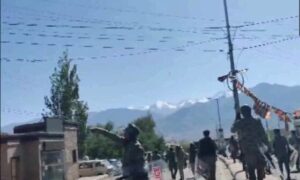
File Picture
Post May 3 suspense is over. India will now go into Lockdown 3.0 as announced by the government. “limited” lockdown, including suspension of inter- state travel, air and train services, will continue to remain in force for another two weeks throughout the country from May 4 but some activities would be allowed after classifying areas into Red, Orange and Green zones.
The government order, which announced extension of the lockdown invoking the Disaster Management Act, said a limited number of activities will remain prohibited throughout the country, irrespective of the zone.
These prohibited activities include travel by air, rail, metro and inter-state movement by road, running of schools, colleges, and other educational and training hospitality services, cinema halls, malls, gymnasiums, sports complexes.
All social, political, cultural and other kinds of gatherings and religious places or places of worship for public will also remain shut, the order said but added that movement of persons by air, rail and road is allowed for select purposes, and for purposes as permitted by MHA.
The home ministry also issued new guidelines to regulate different activities in this period, based on the risk profiling of the districts of the country into new zones with ‘Red’ signifying a hotspot.
The statement said that the Union health ministry would be sharing classification of districts into zones to the states and union territories on weekly basis.
The statement said that outside the containment zone falling within Red zones, certain activities are prohibited in addition to those prohibited throughout the country which includes plying of cycle rickshaws and auto-rickshaws, running of taxis and cab aggregators; intra-district and inter-district plying of buses; and, barber shops, spas and saloons.
However, some activities have been allowed in the red zones with restrictions that includes movement of individuals and vehicles is allowed only for permitted activities, with a maximum of two persons (besides the driver) in four-wheeler vehicles, and with no pillion rider in the case of two-wheelers.
Industrial establishments in urban areas including Special Economic Zones, Export Oriented Units, industrial estates and industrial townships with access control have been permitted.
Construction activities in urban areas have been limited to in-situ construction (where workers are available on site and no workers are required to be brought in from outside) and construction of renewable energy projects.
Shops in urban areas, for non-essential goods, are not allowed in malls, markets and market complexes. However, all standalone (single) shops, neighbourhood (colony) shops and shops in residential complexes are permitted to remain open in urban areas, without any distinction of essential and non-essential.
E-Commerce activities in the Red Zones are permitted only in respect of essential goods and private offices can operate with up to 33 per cent strength as per requirement, with the remaining persons working from home.
All government offices shall function with senior officers of the level of Deputy Secretary and above at full strength, and the remaining staff attending up to 33 per cent as per requirement.
Most of the commercial and private establishments have been allowed in the red zones which includes print and electronic media, IT and IT enabled services, data and call centres, cold storage and warehousing services, private security and facility management services, and services provided by self-employed persons except for barbers.
The statement said that the Orange Zones, in addition to activities permitted in Red Zone, taxis and cab aggregators will be permitted with one driver and one passenger only.
Inter-district movement of individuals and vehicles will be allowed for permitted activities only.
Four-wheeler vehicles will have maximum two passengers besides the driver and pillion riding will be allowed on two-wheelers.
In the Green Zones, all activities are permitted except the limited number of activities which are prohibited throughout the country, irrespective of the Zone. However buses can operate with up to 50 per cent seating capacity and bus depots can operate with up to 50 per cent capacity.
[the_ad id=’22723′]


















